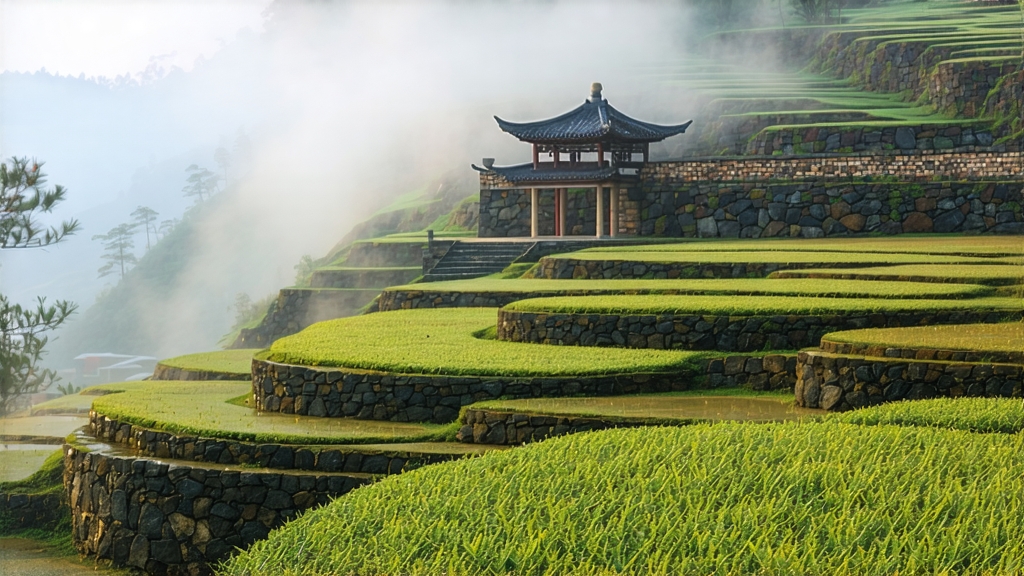
Among the six major chromatic families of Chinese tea, yellow tea is the rarest and most enigmatic; even within China, many drinkers have never tasted an authentic example. Of the handful of yellow teas that survive, Meng Ding Huang Ya from Sichuan’s Mt. Meng crowns the list both historically and sensorially. Once reserved for Tang and Song dynasty emperors, this “yellow bud” tea vanished from court records during the wars of the early twentieth century, only to be resurrected in the 1960s by a small group of retired monks who still remembered the oral choreography of its making. Today, fewer than 3,000 kg of true Meng Ding Huang Ya reach the market each spring, making each sip a liquid time-capsule of Chinese court culture and mountain ecology.
Mt. Meng rises just 1,450 m above the Chengdu plain, but its position at the seam of Sichuan basin humidity and Tibetan plateau chill creates a micro-climate of perpetual fog. The cloud curtain filters sunlight into a soft, diffused glow that slows photosynthesis, forcing the tea bushes—mostly the small-leaf local cultivar “Meng Ding Qun Ti Zhong”—to stock amino acids at the expense of bitter catechins. The result is a bud so tender that it can be peeled like a lychee, revealing a downy core the color of fresh corn silk. Picking begins at Qingming (early April) when the dew point is still below 8 °C; only the single unopened bud or the bud-with-just-unfurling-leaf standard is accepted. Experienced pluckers finish their quota before 9 a.m. so that the leaf remains in metabolic stasis, a prerequisite for the enzymatic choreography that follows.
The crafting of Meng Ding Huang Ya is summarized by four Chinese verbs—sha qing (kill-green), men huang (sealed yellowing), ci hong (primary drying), and ti xiang (aroma lifting)—but each verb hides a labyrinth of timing and intuition. After a 30-second 160 °C tumble in a bamboo-fired wok that denatures leaf enzymes without caramelizing sugars, the leaves are immediately wrapped in thick yellow cotton cloth and slid into a pine-wood chamber kept at 28 °C and 75 % RH. Here begins the sealed yellowing, the hallmark step that distinguishes yellow from green tea. Over the next 72 hours the cloth bundles are opened every eight hours to release trapped CO₂ and re-wrapped with alternating tightness; the leaf slowly suffocates and re-oxygenates, allowing non-enzymatic oxidation of chlorophyll into pheophytin, the pigment responsible for the tea’s brilliant straw-yellow liquor. If the wrapper is too loose, the leaf greens and reverts to green tea; too tight and it collapses into sour compost. Mastery lies in reading the aroma that escapes the knot: when the scent shifts from cut grass to warm pumpkin, the yellowing is complete.
The now-lemon-yellow leaf is dried twice—first at 80 °C on bamboo trays above charcoal embers to reduce moisture to 10 %, then at 60 °C for another two hours while the tea master rolls the leaf between fingers, judging by touch when the bud spine snaps cleanly. A final “aroma lift” at 50 °C for twenty minutes coaxes a residual popcorn sweetness from the bound amino acids, after which the tea is rested for seven days in unglazed clay jars so that the last traces of “fire qi” dissipate. When finished, one thousand buds weigh barely twenty grams, and the dry leaf smells like dried apricot skin and pine honey.
To brew Meng Ding Huang Ya, western tea metrics must be un-learned. The goal is not extraction maximization but spatial choreography of the bud. Use a tall, thin-walled glass or a 120 ml porcelain gaiwan; pre-warm with 75 °C water, then fill one-third of the vessel with leaf—roughly 3 g. The first infusion is a 45-second “awakening” pour that barely covers the buds; they swell and stand upright like miniature golden spires, a phenomenon locals call “Buddha’s light rising.” The second infusion, at 78 °C for one minute, yields the classic cup: a brilliant canary liquor with a viscosity that clings to the rim of the glass like fine Sauternes. Aroma oscillates between sweet corn, fresh orchid, and a hint of alpine sage; the taste is umami-sweet at first touch, then expands into steamed